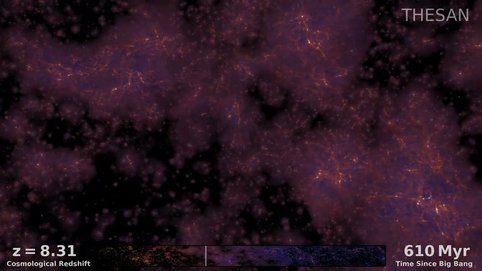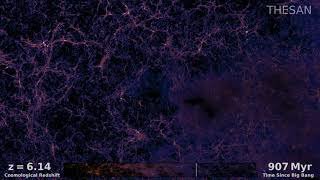Scientists develop the largest, most detailed model of the early universe to date
The Thesan simulations help explain how light from the first galaxies transformed the Universe.
Using the state-of-the-art Thesan cosmological simulation, an international team of scientists has simulated the early universe, when the first stars began to shine. Combining models for galaxy formation, the interaction of starlight with gas and cosmic dust, the simulations have produced the most detailed view of cosmic reionization, across the largest volume of space, of any existing simulation.
It all started around 13.8 billion years ago with a “Big Bang” that brought the universe suddenly and spectacularly into existence. Soon after, the infant Universe became cold and dark – at least until, a few hundred million years later, gravity gathered matter into the first stars and galaxies. Like a cosmic dawn, the first light from these first stars warmed up the surrounding gas, and transformed it into a hot, ionized plasma – a crucial transformation, known as “cosmic reionization”, that propelled the universe into the complex structure that we see today.
Now scientists can get a detailed view of how the universe may have unfolded during this pivotal period with a new simulation, named Thesan, developed jointly by scientists at the Max Planck Institute for Astrophysics (MPA), MIT, and Harvard University. Named after the Etruscan goddess of the dawn, Thesan is designed to simulate the “cosmic dawn”, and specifically cosmic reionization. This period has been challenging to reconstruct, as it involves immensely complicated, chaotic interactions, including those between gravity, gas, and radiation.

“Other previous simulations were not able to match how galaxies influence their surrounding gas in the young universe,” MPA scientist Enrico Garaldi explains his motivation to start working on this project three years ago. “Now, after all this work, I am happy to say that Thesan is the first simulation that quantitatively explains how much the first galaxies ionise the gas in their vicinity.”
The Thesan simulation resolves these interactions with the highest detail and over the largest volume of any existing calculation. It is 300 million light years across, and simulates a billion years of Universe evolution.
So far, the simulations align with the few observations astronomers have of the early universe. As more observations are made of this period, for instance with the newly launched James Webb Space Telescope, Thesan may help to place such observations in cosmic context.
“Thesan acts as a bridge to the early universe,” says Aaron Smith, a NASA Einstein Fellow in MIT’s Kavli Institute for Astrophysics and Space Research. “It is intended to serve as an ideal simulation counterpart for upcoming observational facilities, which are poised to fundamentally alter our understanding of the cosmos.”
To fully simulate cosmic reionization, the team sought to include as many major ingredients of the early universe as possible. They started with a successful model of galaxy formation that their groups previously developed, called Illustris-TNG. They then developed a new code to incorporate how the light from galaxies and stars interact with and reionize the surrounding gas.
“Thesan follows how the light from these first galaxies interacts with the gas over the first billion years and transforms the universe from neutral to ionized,” Rahul Kannan of the Harvard-Smithsonian Center for Astrophysics says. “This way, we automatically follow the reionization process as it unfolds.” Finally, the team included a model of cosmic dust, creating a picture of unique accuracy of the early Universe. This model aims to describe how tiny grains of material influence the formation of galaxies in the early, sparse universe.
With the simulation’s ingredients in place, the team evolved these conditions forward in time to simulate a patch of the universe, using the SuperMUC-NG machine at LRZ in Germany – one of the largest supercomputers in the world. Here, 60,000 computing cores simultaneously carried out Thesan’s calculations over an equivalent of 30 million CPU hours (an effort that would have taken 5,700 years to run on a single desktop).
Thesan look-around
The simulations have produced the most detailed view of cosmic reionization, across the largest volume of space, of any existing simulation. While some simulations model across large distances, they do so at relatively low resolution, while other, more detailed simulations do not span volumes as large as Thesan.
“We developed this simulation not only for our own understanding of the early Universe, but for the entire research community,” stresses Garaldi. “For this reason, we will soon release all the simulation data, for everyone to use! The simulation is so rich and complex, it would take us many, many years to study it all.”














